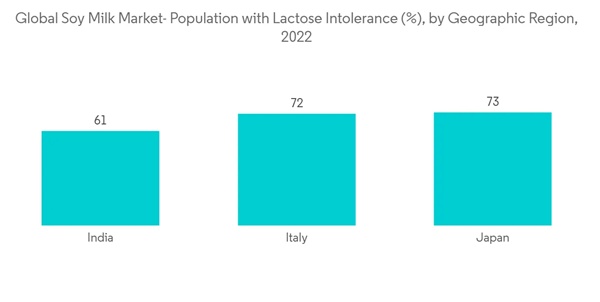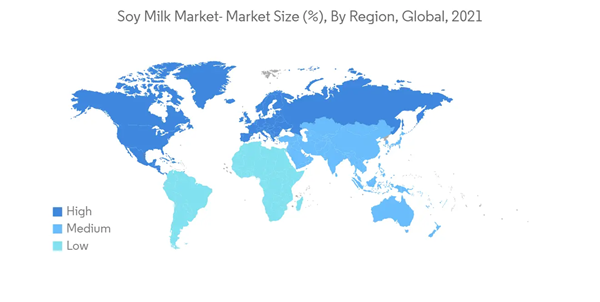The soy milk market is projected to register a CAGR of 6.92% over the next five years.
This product will be delivered within 2 business days.
Key Highlights
- Consumers are beginning to prefer low-calorie products, free of artificial additives and high in protein, pushing the market for soy beverages. Plant-based beverages contain vegetable protein or a combination of proteins, which meet the growing need for a healthy lifestyle.
- Additionally, consumers are increasingly looking for lactose-free dairy alternatives made from plant sources due to rising lactose intolerance and the ongoing trend of veganism. The variety of goods on the shelves meets the taste for novelty and type of health and wellness-oriented consumers. Therefore, the plant-based beverages segment is promising with untapped potential in Asia-Pacific due to soy's traditional acceptance.
- Furthermore, soy milk is used extensively in Chinese, Japanese, Korean, and other East Asian cuisines. Soy milk is also used while producing imitation dairy products such as soy yogurt, soy cream, soy kefir, and soy-based cheese substitutes. It's also used to make milkshakes, pancakes, smoothies, bread, mayonnaise, and baked products.
- The manufacturers' introduction of various flavors like vanilla, chocolate, and strawberry, among others, to mask the aftertaste of soy milk is propelling the product demand among kids as well. Key manufacturers are investing in research and development to curb the aftertaste by introducing more flavors and selling the product in attractive packages via many distribution channels.
- For instance, the Hershey Company has been focused on introducing newer flavors like 'Coffee Mocha' to its portfolio of 'Sofit' beverages, i.e., soy milk drinks, to capture a larger audience and cater to their preferences and health at the same time.
Soy Milk Market Trends
Increasing Prevalence of Lactose Intolerance
- The leading causes of giving up dairy products are the rising prevalence of lactose intolerance and allergies. Cow milk allergy is one of the most common food allergies in newborns and young children, especially in light of the food allergy statistic. For instance, according to ProCon Organization, 2022, 72% of Italians have lactose allergies. As a result, there is an increase in the country's demand for lactose-free milk products.
- Additionally, according to Agriculture and Agri-Food Canada, Brazil's free-from-product retail sales in 2021 totaled USD 848.1 million. Thus, as health consciousness grows, there is a growing demand for dairy-free products milk. Veganism is becoming more popular among customers, which is boosting market expansion around the world. Additionally, the rising number of product launches globally in the lactose-free dairy products category and its acceptance among consumers represents a substantial opportunity for dairy alternative manufacturers.
- The market is gaining popularity across Asian countries such as India, Thailand, Indonesia, and others. People spend on premium products with essential macronutrients and amino acids, good quality fatty acid profiles, vital minerals, vitamins, complex carbohydrates, and many phytochemicals. This, in turn, has provided lucrative opportunities for manufacturers to expand their footprints in such potential and promising markets.
- For instance, in 2021, Hershey India announced that it had developed Soft Plus, a plant protein drink made from soy that was created to meet the nutritional requirements of underprivileged children.
Asia-Pacific Emerges as the Fastest-growing Market
- The Asia-Pacific is the test-growing market as many countries like China, India, Japan, South Korea, and Hong Kong are the primary consumers of the product. The abundant duction of soybean in these countries is also driving consumption in the region. Also, in response to the increasing demand for vegan products and lactose-free dairy products in Asian countries, several strategic investments have been undertaken to push revenue generation in the region. For instance, in 2021, EFKO Group announced its plan to invest RUB 600 million in the venture to produce soy milk, producing a thousand tons of milk per month.
- In Asia-Pacific, consumers are increasingly looking for lactose-free dairy alternatives derived from plant sources, and the choice of products multiplying on the shelves satisfies health and wellness-orientated consumers' taste for novelty and variety. Also, plant-based beverages make up a promising category because of the traditional acceptance of soy.
- Additionally, the manufacturers' introduction of various flavors like vanilla, chocolate, and strawberry, among others, to mask the aftertaste of soy milk is also propelling the product demand among kids.
- Key manufacturers are investing in research and development to curb the aftertaste by introducing more flavors and selling the product in attractive packages via many distribution channels.
- For instance, in March 2022, ITC launched the new Aashirvaard Svasti' Easy Digest Milk' in the Indian market. The company claims that it is a lactose-free product formulated mainly for the lactose-intolerance population.
Soy Milk Market Competitor Analysis
The soy milk market is highly competitive, with a strong presence of regional small-and medium-scale players and key global players. Key providers in this market include Eden Food, the Hershey Company, Campbell Soup, Vitasoy International Holdings, and Kikkoman Pearl Soy Milk. Expansions and new product launches are the most preferred strategies in the global soymilk market. As a part of strategic expansion, key players are adopting an omnichannel distribution strategy, where they tie up with various online retailers, i.e., third parties, like Amazon. This, in turn, broadens their geographical presence and customer base. Key players are focusing on social media platforms and online distribution channels for their online marketing and branding of products to attract more customers. Consumers' changing tastes are pushing manufacturers to introduce new flavors in the market. This is fuelling the growth of flavored soy milk, thereby increasing overall consumption.Additional benefits of purchasing the report:
- The market estimate (ME) sheet in Excel format
- 3 months of analyst support
This product will be delivered within 2 business days.
Table of Contents
1 INTRODUCTION
4 MARKET DYNAMICS
5 MARKET SEGMENTATION
6 COMPETITIVE LANDSCAPE
Companies Mentioned (Partial List)
A selection of companies mentioned in this report includes, but is not limited to:
- Danone SA
- Campbell Soup Company
- The Hershey Company
- VITASOY International Holdings Limited
- The Hain Celestial Group Inc.
- Eden Foods Inc.
- Pure Harvest Smart Farms Company
- Kikkoman Pearl Soy Milk
- American Soy Products Inc.
- The Granarolo Group
Methodology

LOADING...










